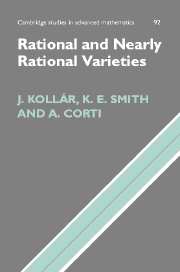5 - The Noether–Fano method for proving nonrationality
Published online by Cambridge University Press: 25 May 2010
Summary
In this chapter, we present the higher–dimensional version of the Noether–Fano technique introduced in Chapter 2 to treat cubic surfaces. The Noether–Fano method forms the basis of most current approaches to birational problems for nearly rational varieties of higher dimension. We apply the method in two cases. First, in Section 3, we show that certain Fano hypersurfaces in weighted projective spaces are not rational. These are by far the simplest cases known but they were discovered only recently. Then, in Section 4, we turn to the very first application, proving that no smooth quartic threefold is rational. This is quite a bit harder and the proof of a key part is completed only in Chapter 6.
The Noether–Fano method is based on the idea that a Fano variety birationally equivalent to another in a nontrivial way must admit a “very singular” linear system. In Chapter 2, we were concerned with surfaces and “very singular” was a simple multiplicity statement. In higher dimensions, the meaning of “very singular” is more subtle and indeed, we expend considerable energy in Chapter 6 to prove a particular numerical bound on the singularities of such a system.
In Section 1, we outline the method, beginning with the Noether–Fano inequality, Theorem 5.5. The main point is that a birational map between Fano varieties of Picard number one arises from a linear system that admits a maximal center, a subvariety of its base locus along which it is particularly singular.
- Type
- Chapter
- Information
- Rational and Nearly Rational Varieties , pp. 122 - 148Publisher: Cambridge University PressPrint publication year: 2004

